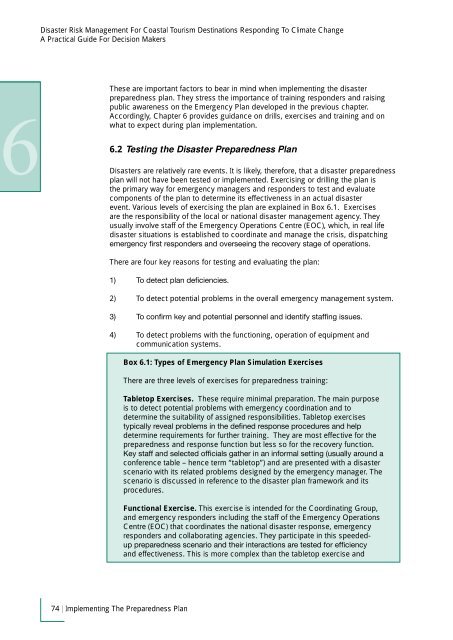Disaster Risk Management For Coastal Tourism Destinations - DTIE
Disaster Risk Management For Coastal Tourism Destinations - DTIE
Disaster Risk Management For Coastal Tourism Destinations - DTIE
You also want an ePaper? Increase the reach of your titles
YUMPU automatically turns print PDFs into web optimized ePapers that Google loves.
<strong>Disaster</strong> <strong>Risk</strong> <strong>Management</strong> <strong>For</strong> <strong>Coastal</strong> <strong>Tourism</strong> <strong>Destinations</strong> Responding To Climate Change<br />
A Practical Guide <strong>For</strong> Decision Makers<br />
These are important factors to bear in mind when implementing the disaster<br />
preparedness plan. They stress the importance of training responders and raising<br />
public awareness on the Emergency Plan developed in the previous chapter.<br />
Accordingly, Chapter 6 provides guidance on drills, exercises and training and on<br />
what to expect during plan implementation.<br />
6.2<br />
Testing the <strong>Disaster</strong> Preparedness Plan<br />
<strong>Disaster</strong>s are relatively rare events. It is likely, therefore, that a disaster preparedness<br />
plan will not have been tested or implemented. Exercising or drilling the plan is<br />
the primary way for emergency managers and responders to test and evaluate<br />
components of the plan to determine its effectiveness in an actual disaster<br />
event. Various levels of exercising the plan are explained in Box 6.1. Exercises<br />
are the responsibility of the local or national disaster management agency. They<br />
usually involve staff of the Emergency Operations Centre (EOC), which, in real life<br />
disaster situations is established to coordinate and manage the crisis, dispatching<br />
<br />
There are four key reasons for testing and evaluating the plan:<br />
<br />
<br />
2) To detect potential problems in the overall emergency management system.<br />
<br />
<br />
4) To detect problems with the functioning, operation of equipment and<br />
communication systems.<br />
Box 6.1: Types of Emergency Plan Simulation Exercises<br />
There are three levels of exercises for preparedness training:<br />
Tabletop Exercises. These require minimal preparation. The main purpose<br />
is to detect potential problems with emergency coordination and to<br />
determine the suitability of assigned responsibilities. Tabletop exercises<br />
<br />
determine requirements for further training. They are most effective for the<br />
preparedness and response function but less so for the recovery function.<br />
<br />
conference table – hence term “tabletop”) and are presented with a disaster<br />
scenario with its related problems designed by the emergency manager. The<br />
scenario is discussed in reference to the disaster plan framework and its<br />
procedures.<br />
Functional Exercise. This exercise is intended for the Coordinating Group,<br />
and emergency responders including the staff of the Emergency Operations<br />
Centre (EOC) that coordinates the national disaster response, emergency<br />
responders and collaborating agencies. They participate in this speeded-<br />
<br />
and effectiveness. This is more complex than the tabletop exercise and<br />
74 | Implementing The Preparedness Plan

















